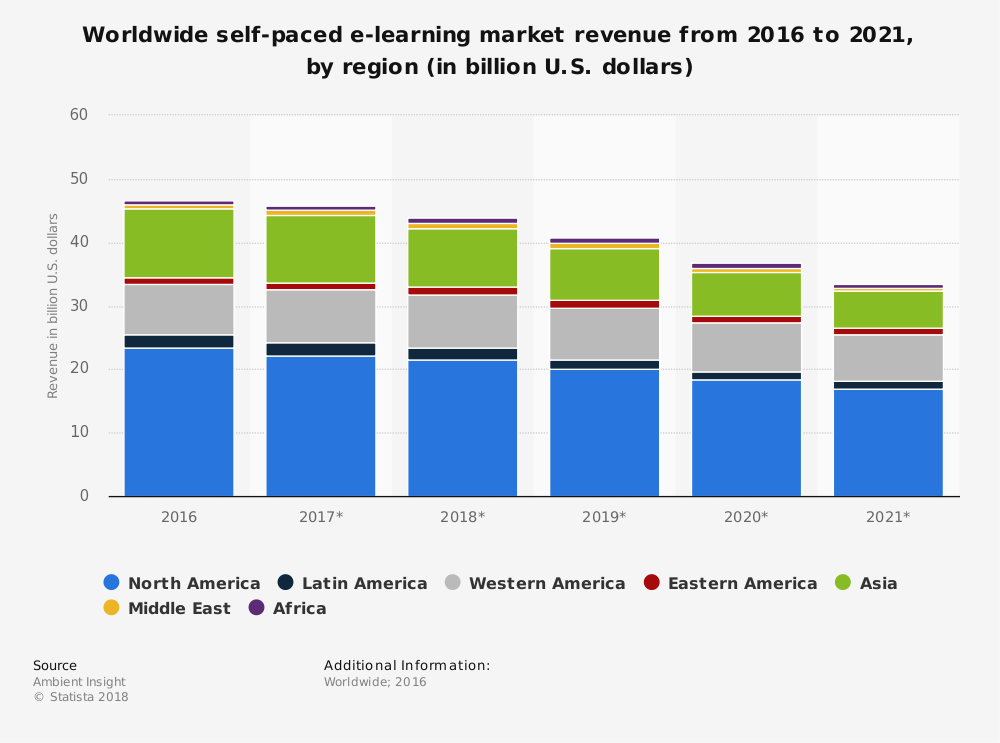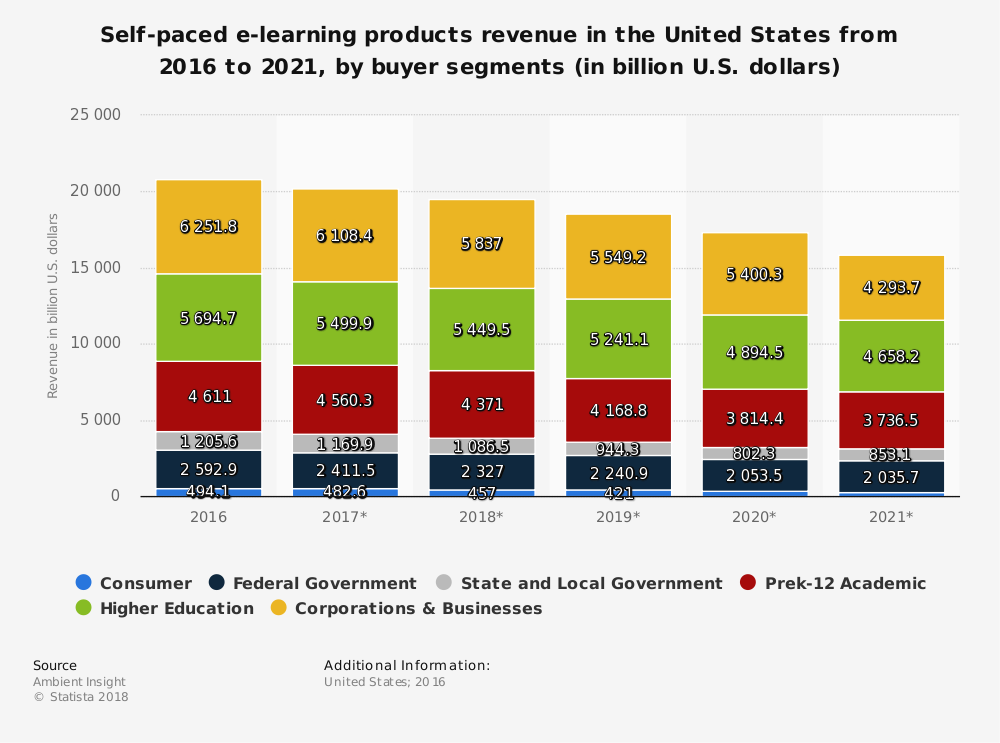As an industry, eLearning was developed in 1999 to accommodate the growing saturation rates of internet access. Virtual learning, online learning, and digital learning all fall under the spectrum of the eLearning industry.
Studying by correspondence, however, is not a new concept. As early as the 1840s, students were being taught through written correspondence. Testing machines were developed in 1924 to allow students to test on their own, without the need for a teacher or professor. In 1954, Professor B.F. Skinner invented a teaching machine that could administer programmed instructions to students.
From these early days of correspondence, eLearning has developed into an industry that allows educational institutions to issue undergraduate, graduate, and doctorate degrees with minimal in-classroom work. Employers are using eLearning to improve the speed of professional development for their teams.
The eLearning industry today is arguably more popular than it has ever been.
Important eLearning Industry Statistics
#1. The eLearning industry brought in $51.5 billion in revenues in 2016. 78% of educational institutions are using a learning management system that makes it possible to provide online lessons. (eLearning Industry)
#2. There are more than 700 learning management system providers currently operating within the industry. They have helped to fuel industry growth of more than 900% within the last 17 years. (eLearning Industry)

#3. Organizations in the United States are taking advantage of the structures found in eLearning courses as well. 77% of businesses now offer a web-based program that helps to train employees. (eLearning Industry)
#4. When students or employees are enrolled in an eLearning opportunity, they spend up to 60% less time covering the same material as they would in a traditional classroom scenario. (Shift eLearning)
#5. The information retention rates for students enrolled in an eLearning program are up to 60% better than they are in a typical lecture-based classroom environment. (Shift eLearning)
#6. The average student enrolled in an eLearning program will learn up to 5 times more material than they would in a traditional classroom without increasing the amount of time they spend in class. (Shift eLearning)
#7. 42% of companies that have implemented an eLearning program say that it has led to increased revenues. eLearning technologies allow employees to receive an 18% boost to their engagement levels. (Shift eLearning)
#8. For every $1 that is invested into an eLearning program, up to $30 in productivity can be generated. (Shift eLearning)
#9. When eLearning opportunities are available to employees, the revenue generated by that employee is 26% higher when compared to the general workforce. IBM was able to save nearly $200 million just by switching to an eLearning program. (Shift eLearning)
#10. The global eLearning market is expected to surpass $243 billion in value by 2022. Self-paced eLearning products currently generated more than $46 billion in revenues. (Statista)

#11. 43% of U.S.-based college students state that eLearning technologies are “extremely helpful” for the completion of their homework. (Statista)
#12. 81% of students in the United States said that access to an eLearning program helped them to raise their grades in a 2016 survey. (Statista)
#13. Online practice quizzes are the most common type of digital learning technology that is used by students in the United States. The results of using all learning technologies is that eLearning improves student studying efficiency. (Statista)
#14. 495 of global students have taken at least one online course in the past year. (Statista)
#15. Two-thirds of people utilize a mobile device to access their eLearning courses. 99% of students who use a mobile device for their online learning needs say that mobile eLearning has enhanced their educational experience. (eLogic Learning)
#16. Although 1 in 4 students took at least one distance education course in the last quarter, semester, or trimester, 74% of students are not currently enrolled in any distance education courses at all. (Babson Survey Research Group)
#17. 35% of U.S.-based college students enrolled exclusively in eLearning course offered at private, for-profit institutions in 2012. That meant about 1 million students were learning exclusively through eLearning opportunities. (US News and World Report)
#18. The Plains is the region of the US which sees the highest rates of eLearning, with 23% of students actively enrolled in a program. The Southwest, as a region, comes in second at 20%. Many other regions, including the Midwest and New England, don’t even get their enrollment percentages into double digits. (US News and World Report)
#19. Graduate students are more likely to take advantage of eLearning options than undergraduate students. 22% of the 2.9 million graduate students in the U.S. are exclusively studying online. Undergraduate eLearning rates are just half of the graduate student rates. (US News and World Report)
#20. About 35,000 students that are not based in the United States are studying exclusively online through a U.S.-based eLearning program. (US News and World Report)

#21. Arizona has the highest rate of eLearning enrollment in the United States, with 48% of students studying exclusively online. West Virginia and Iowa follow, with enrollment rates at 40% and 39.7% respectively. (US News and World Report)
#22. 64% of the teaching faculty at community colleges in the United States are teaching eLearning courses. 35% of part-time faculty are also involved in the eLearning process. (EdTech Magazine)
#23. The completion rate for online courses is actually lower than it is for classroom-based courses. Students in classrooms complete 76% of courses, while online students complete 72% of their courses. (EdTech Magazine)
#24. About 1 in 4 students are enrolled in at least one online course to achieve their 2-year Associates degree. (EdTech Magazine)
#25. 7 out of 10 leaders at for-profit educational institutions report that eLearning courses are offered at their facility. From those leaders with eLearning at their schools, more than half say that the value of an online course is equal to the value of learning in the traditional classroom. (EdTech Magazine)
#26. Liberal arts institutions are the least likely to offer eLearning opportunities (62%). Research universities (79%) and community colleges (82%) tend to offer programs that feature exclusive eLearning opportunities. (EdTech Magazine)
#27. 15% of college students in the United States who have taken advantage of modern eLearning opportunities have earned their entire degree from online coursework. (EdTech Magazine)
#28. In 2014, the eLearning industry was valued at $56.2 billion. In 2015, the industry nearly doubled in value, reaching $107 billion. In 2011, $35.6 billion was spent on self-paced eLearning opportunities globally. (Inc.)
#29. In 2015, the overall eLearning market was estimated to have a maximum market cap of $165 billion globally. The CAGR for the industry through 2023 is forecast to be 5%. (Docebo)
#30. The eLearning industry in the United States is estimated to be around $27 billion, with a similar forecast for growth at 5% annually through 2023. (Docebo)
#31. Outside of North America, the largest market for self-directed eLearning is Asia. More than $10.9 billion in revenues is generated annually. (Docebo)
#32. Africa offers the fewest opportunities for revenues currently, generating just $607 million in revenues in 2016. It also offers the largest potential for growth, as the internet penetration rates for the continent are just 35%. (Docebo / Internet World Stats)
#33. 62% of students believe that eLearning opportunities offer full-time working professionals an opportunity to expand their experience and education. (EdTech Magazine)
#34. Faculty members (48%) are less likely than students (53%) to feel that eLearning is essential for classroom experiences in the 21st century. (EdTech Magazine)
#35. In the United States, about 90% of 4-year public educational institutions offer eLearning opportunities. In comparison, just 3 out of 5 private colleges and universities make eLearning available. (EdTech Magazine)
#36. 2 out of 5 community colleges in the United States maintain servers they own to provide eLearning access for their enrolled students. (EdTech Magazine)
#37. Companies state that the reason why they use learning management systems are to improve the user experience (88%), improve administrative experiences (73%), and to enhance reporting and system integration (66%). (Brandon Hall Group Training Study)
#38. 39% of Millennials say that they wish to see more virtual education opportunities within the workforce. By 2025, Millennials will be an estimated 75% of the workforce in the United States. (Edge Point Learning)
#39. On-demand markets are growing at a parallel rate to the eLearning industry. More than 22 million consumers in the United States prefer using on-demand services compared to more traditional service offerings. (Docebo)
#40. 2 out of every 5 companies that are listed in the Fortune 500 are using products or services from the eLearning industry. (Edge Point Learning)
#41. The rise of MOOCs – Massive Open Online Courses – has allowed companies like Coursera to introduce over 300 courses from 62 different universities in 17 countries. More than 2.9 million people are registered on their platform. (Scientific American)
#42. 30% of MOOCs are science-based classes. 28% are based in the arts and humanities, while 23% are based in Information Technology. (Scientific American)
#43. 3 out of every 4 student enrollments in MOOCs originates from outside the United States. India has the highest level of international student enrollment, providing 8.8% of students enrolled in MOOCs. (Scientific American)
#44. 89% of Chief Academic Officers (CAOs) believed that students require more discipline to complete online courses. 40% of CAOs believe that students who complete eLearning courses will have a more difficult time finding employment after receiving their degree. (Online Learning Survey – Allen and Seaman)
#45. Over the past 10 years, there has been a 26% increase in the number of universities that have committed resources to building eLearning infrastructures. (WizIQ)
#46. 9.4% of universities in the United States currently have MOOCs in a planning stage. Another 2.6% of universities already have a MOOC. One of the hesitations to implement this type of class is that the complete rate for MOOC students is just 15%. (Framed Lightscapes LLC)
#47. Online classes that are taken at home can cost 25% less than the traditional costs of attending an out-of-state school. (Classes and Careers)
eLearning Industry Trends and Analysis
New technologies are helping the eLearning industry continue to expand. Virtual reality and augmented reality help students who are visually-orientated to receive the same immersive online environments that text-based students have received for nearly 20 years. Chatbots and IA options like Siri or Cortana make it easier for students to multitask and organize their learning schedules.
Even game-based learning is having a positive impact on the retention of role-based information that is deemed to be critical.
When the eLearning industry first began in 1999, the awards and degrees that were offered were not always taken seriously. As educational institutions pursued accreditation for their online learning programs and adaptive learning opportunities came into the industry, the views of eLearning quickly changed.
It is faster, easier, and cheaper to learn new skills or subject materials through eLearning. In 2014, there were 5.8 million students enrolled in online courses in the United States. More than half of all students in 2016 took at least one online class and one traditional classroom course to complete their degree program.
eLearning is causing on-campus enrollment to shrink. More learning opportunities are available. That is why many are bullish on this industry and expect it to achieve great success in the coming years.
Although millions of people visit Brandon's blog each month, his path to success was not easy. Go here to read his incredible story, "From Disabled and $500k in Debt to a Pro Blogger with 5 Million Monthly Visitors." If you want to send Brandon a quick message, then visit his contact page here.
